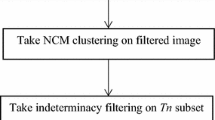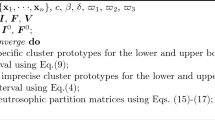Abstract
A new clustering algorithm, neutrosophic evidential c-means (NECM) is introduced based on the neutrosophic set (NS) and the evidence theory. The clustering analysis is formulated as a constrained minimization problem, whose solution depends on an objective function. In the objective function of NECM, two new types of rejection have been introduced using NS theory: the ambiguity rejection which concerns the patterns lying near the class boundaries, and the distance rejection dealing with patterns that are far away from all the classes. A belief function evidence theory is employed to make the final decision, and it is defined using the concept of Dezert–Smarandache theory of plausible and paradoxical reasoning, which is a natural extension of the classical Dempster–Shafer theory. A variety of experiments were conducted using synthetic and real data sets. The results are promising and compared favorably with the results from the evidential c-means algorithm on the same data sets. We also applied the proposed method into the image segmentation. The experimental results show that the proposed algorithm can be considered as a promising tool for data clustering and image processing.


Similar content being viewed by others
References
Andenberg MR (1973) Cluster analysis for applications. Academic Press, New York
Pal SK (1991) Fuzzy tools in the management of uncertainty in pattern recognition, image analysis, vision and expert systems. Int J Syst Sci 22:511–549
Bezdek JC (1987) Pattern recognition with fuzzy objective function algorithms. Plenum Press, New York
Ruspini E (1969) A new approach to clustering. Inf Control 15:22–32
Godara S, Verma A (2013) Analysis of various clustering algorithms. Int J Innov Technol Explor Eng 3(1):186–189
Verma M, Srivastava M, Chack N, Diswar AK, Gupta N (2012) A comparative study of various clustering algorithms in data mining. Int J Eng Res Appl 2(3):1379–1384
Baraldi A, Blonda P (1999) A survey of fuzzy clustering algorithms for pattern recognition—part I. IEEE Trans Syst Man Cybern B Cybern 29(6):778–785
Jiang H, Liu Y, Ye F, Xi H, Zhu M (2013) Study of clustering algorithm based on fuzzy C-means and immunological partheno genetic. J Softw 8(1):134–141
Omar W, Badr A, El-Fattah A (2013) Hegazy, clustering algorithm with cluster analysis techniques. J Comput Sci 9(6):780–793
Chen N, Xu Z, Xia M (2013) Correlation coefficients of hesitant fuzzy sets and their applications to clustering analysis. Appl Math Model 37:2197–2211
Gana H, Sanga N, Huanga R, Tongb X, Dana Z (2013) Using clustering analysis to improve semi-supervised classification. Neurocomputing 101(4):290–298
Karaboga D, Ozturk C (2011) A novel clustering approach: artificial bee colony (ABC) algorithm. Appl Soft Comput 11:652–657
Napoleon D, Pavalakodi S (2011) A new method for dimensionality reduction using K-means clustering algorithm for high dimensional data set. Int J Comput Appl 13(7):41–46
Smets P (1998) The transferable Belief Model for quantified belief representation. In: Gabbay DM, Smets P (eds) Handbook of defeasible reasoning and uncertainty management systems, vol 1. Kluwer Academic Publishers, Dordrecht, pp 267–301
DenWux T, Masson MH (2004) EVCLUS: evidential clustering of proximity data. IEEE Trans Syst Man Cybern Part B 34(1):95–109
Masson MH, Denoeux T (2008) ECM: an evidential version of the fuzzy c-means algorithm. Pattern Recogn 41:1384–1397
Masson MH, Denoeux T (2009) RECM: relational evidential c-means algorithm. Pattern Recogn Lett 30:1015–1026
Antoine V, Quost B, Masson MH, Denœux T (2012) CECM: constrained evidential c-means algorithm. Comput Stat Data Anal 56:894–914
Smarandache F, Dezert J (2009) Advances and applications of DSmT for information fusion, vol 3. American Research Press
Dezert J, Smarandache F (2005) An introduction to DSm theory of plausible, paradoxist, uncertain, and imprecise reasoning for information fusion. In: 13th international congress of cybernetics and systems. Maribor, Slovenia, July 6–10, 2005
Smarandache F (2003) A unifying field in logics neutrosophic logic. Neutrosophy, neutrosophic set, neutrosophic probability, 3rd edn. American Research Press, Rehoboth, NM
Kandasamy WB, Smarandache F (2006) Neutrosophic algebraic structures. Hexis, Phoenix
Salim BC, Mounir S, Farhat F, Eric B (2010) Colour image segmentation using homogeneity method and data fusion techniques. EURASIP J Adv Signal Process. doi:10.1155/2010/367297
Zhu YM, Bentabet L, Dupuis O, Kaftandjian V, Babot D, Rombaut M (2002) Automatic determination of mass functions in Dempster–Shafer theory using fuzzy c-means and spatial neighborhood information for image segmentation. Opt Eng 41(4):760–770
Yager RR (1999) Class of fuzzy measures generated from a Dempster–Shafer belief structure. Int J Intell Syst 14(12):1239–1247
Windham MP (1985) Numerical classification of proximity data with assignment measure. J Classif 2:157–172
Fisher RA (1936) The use of multiple measurements in taxonomic problems. Ann Eugen 7:179–188
Setiono R (2000) Generating concise and accurate classification rules for breast cancer diagnosis. Artif Intell Med 18:205–219
Author information
Authors and Affiliations
Corresponding author
Rights and permissions
About this article
Cite this article
Guo, Y., Sengur, A. NECM: Neutrosophic evidential c-means clustering algorithm. Neural Comput & Applic 26, 561–571 (2015). https://doi.org/10.1007/s00521-014-1648-3
Received:
Accepted:
Published:
Issue Date:
DOI: https://doi.org/10.1007/s00521-014-1648-3




